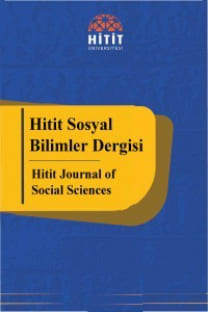EKONOMETRİK YAKLAŞIM YOLUYLA TÜRKİYE’DE KAYIT DIŞI EKONOMİNİN TAHMİNİ
Bu çalışmanın amacı, 1986-2015 dönemi için ekonometrik yaklaşım aracılığıyla Türkiye’de kayıt dışı ekonominin boyutlarını tahmin etmektir. ARDL prosedürü takip edilerek elde edilen tahmin sonuçlarına göre, kayıt dışı ekonominin büyüklüğünde bir azalma eğiliminin olduğu gözükmektedir. Kayıt dışı ekonominin büyüklüğünün sıfır olması yasa dışı faaliyetlerin varlığı nedeniyle beklenilen bir durum değildir. Önemli olan bu kapsam dışında kalan ekonomik faaliyetler bağlamında kayıt dışına çıkmayı cazip kılacak motivasyonları en aza indirecek yönde adımların atılmasıdır.
Anahtar Kelimeler:
Kayıt Dışı Ekonomi, Ekonometrik Yaklaşım, ARDL, Türkiye
___
- Adam, M.C. & Ginsburgh, V.A. (1985). The Effects of Irregular Markets on Macroeconomics Policy: Some Estimates for Belguim. European Economic Review, 29(1), 15-33.
- Akalın, G. & Kesikoğlu, F. (2007). Türkiye’de Kayıt Dışı Ekonomi ve Büyüme İlişkisi. ZKÜ Sosyal Bilimler Dergisi, 3(5), 71-87.
- Aktürk, E. (2005). Türkiye′de Kayıt Dışı Ekonomi: Sebepleri ve Çözüm Önerileri. Ekev Akademi Dergisi, 23, 285-300.
- Altuğ, O. (1999). Kayıt Dışı Ekonomi, İstanbul: Türkmen Kitabevi.
- Aslanoğlu, S. & Yıldız, S. (2007). Türkiye’de Kayıt Dışı Ekonomi Olgusu, Bu Olguyu Azaltmaya Yönelik Çözüm Arayışları ve Bir Öneri: Rasyo Analizi Yoluyla Etkin Bir İnceleme Sisteminin Oluşturulması. Sosyo Ekonomi, 2, 127-146.
- Baldemir, E., Gökalp, F. & Avcı, M. (2005). Türkiye’de Kayıt Dışı Ekonomi’nin MIMIC Modelle Tahminlenmesi. Süleyman Demirel Üniversitesi İİBF Dergisi, 10(2), 231-243.
- Çetintaş, H. & Vergil, H. (2003), Türkiye′de Kayıt Dışı Ekonomi Tahmini. Doğuş Üniversitesi Dergisi, 4(1), 15-30. Dell'Anno, R. & Halıcıoğlu, F. (2010). An ARDL Model of Unrecorded and Recorded Economies in Turkey. Journal of Economic Studies, 37(6), 627-646.
- Elgin, C. & Öztunalı, O. (2012). Shadow Economies Around the World: Model Based Estimates. Bogazici University Department of Economics Working Papers, 5, 1-48. Enste, D. H. (2003). Shadow Economy and Institutional Change in Transition Countries: The informal Economy in the EU Accession Countries: Size, Scope, Trends and Challenges to the Process of EU Enlargement. B. Belev (Eds), Centre for the Study of Democracy, Sofia, 81-113.
- Erkuş, H. & Karagöz, K. (2009). Türkiye’de Kayıt Dışı Ekonomi ve Vergi Kaybının Tahmini. Maliye Dergisi, 156, 126-140.
- Feige, E. L. (1990). Defininig and Estimating Underground and Informal Economies: The New Institinational Economics Approach. World Development, 18(7), 1-29.
- Frey, B.S. & Schneider, F. (2000). Informal and Underground Economy. International Encylopedia of Social and Behavioral Science.
- Gutmann, P. M. (1977). The Subterranean Economy. Financial Analsts Journal, 34(1), 24-27.
- Halıcıoglu, F. (2004). An ARDL Model of International Tourist Flows to Turkey. Global Business and Economics Review, Anthology, 614-624.
- Işık, N. & Acar, M. (2003). Kayıt Dışı Ekonomi: Ölçme Yöntemleri, Boyutları, Yarar ve Zararları Üzerine Bir Değerlendirme. Erciyes Üniversitesi İktisadi ve İdari Bilimler Fakültesi Dergisi, 21, 117- 136.
- Kirmaoğlu, H. & Miscioğlu, K. İ. (2016). Yolsuzluk Raporları 2016: Türkiye’de Kayıt Dışı Ekonomi. TESEV Yayınları, 1-32.
- Öğünç, F. & Yılmaz, G. (2000). Estimating The Underground Economy In Turkey. The Central Bank of the Republic of Turkiye, Research Departmant. Discussion Paper” The Central Bank of Republic of Turkey. Ankara.
- Özsoylu, A.F. (1996). Türkiye′de Kayıt Dışı Ekonomi, Ankara: Bağlam Yayıncılık.
- Pesaran, M. H.; Shin, Y. & Smith, R. J. (2001). Bounds Testing Approaches to the Analysis of Level Relationships. Journal of Applied Econometrics, 16(3), 289-326.
- Savaşan, F. (2011). Türkiye′de Kayıt Dışı Ekonomi ve Kayıt Dışılıkla Mücadelenin Serencamı. Siyaset, Ekonomi ve Toplum Araştırması Vakfı, 35.
- Savaşan, F. ve Altındemir, M.E. (2007). Corruption and Hidden Economy: Letting the Fingerprints Tell the Story. European Journal of Economics, 7, 114-130.
- Schneider, F. (2012). The Shadow Economy and Work in the Shadow Economy: What Do We (Not) Know?. Institue of The Study of Labor Discussion Paper Series 6423.
- Schneider, F. & Enste, D.H. (2000). Shadow Economies: Size, Cause and Consequences. Journal of Economic Literature, 38, 77-114.
- Schneider, F. & Enste, D.H. (2002). The Shadow Economy. United Kingdom: Cambridge University Press.
- Schneider, F. & Savaşan, F. (2007). Dymimic Estimates of the Size of Shadow Economies of Turkey and of Her Neighbouring Countries. International Research Journal of Finance and Economics, 9, 126-143.
- Sugözü, H.İ. (2010). Kayıt Dışı Ekonomi ve Türkiye, Ankara: Nobel Yayınevi.
- Tanzi, V. (1983). The Undurground Economy in the United States: Annual Estimates: 1930-1980. IMF-Staff Papers, 30(2), 283-305.
- Temel, A., Şimşek, A. & Yazıcı, K. (1994). Kayıt Dışı Ekonomi Tanım, Tespit Yöntemleri ve Türk Ekonomisindeki Büyüklüğü. İktisat-İşletme ve Finans Dergisi, 104, 10 – 33.
- Us, V. (2004). Kayıt Dışı Ekonomiyi Tahmin Yöntem Önerisi: Türkiye Örneği. Türkiye Ekonomi Kurumu- Tartışma Metni.
- Yazici, M. & Islam, M. Q. (2014). Exchange Rate and Bilateral Trade Balance of Turkey with EU (15) Countries. Journal of Business Economics and Finance, 3(3), 341-356.
- Yayın Aralığı: Yılda 2 Sayı
- Başlangıç: 2008
- Yayıncı: Hitit Üniversitesi
Sayıdaki Diğer Makaleler
HEMŞİRELİK ÖĞRENCİLERİNİN ZİHİNSEL ENGELLİ BİREYLERE YÖNELİK SOSYAL MESAFELERİNİN İNCELENMESİ
Canan AYDOĞAN, Hüsamettin ÇETİN
BİLİME ADANMIŞ ÖMÜR: NASURİDDİN TUSİ
ENFLASYON-FAİZ İLİŞKİSİ BİR ARDL/SINIR TESTİ UYGULAMASI
Bünyamin DEMİRGİL, Hakan TÜRKAY
